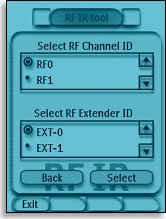|
...Continued from Page 20.
All buttons on the TSU3000 also have a troubling lag between the time they are pressed and the time the command is finally transmitted. While most remotes (including the original Pronto) operate on an instantaneous basis – the instant you make contact with the button is the instant the command begins transmitting – the Pronto NG has a quarter to half second delay on both LCD and hard buttons. The remote beeps instantly, but the command isn’t sent until later. Worse still, if buttons are tapped too quickly some commands are dropped – even if the remote beeped for each. Enter the digits for channel “185” in rapid succession and you may get channel “15”. Finally, the minimum transmit time on the TSU3000 is slightly longer than previous Prontos, further impacting how quickly buttons can be sequentially pressed.
Infrared hide and seek.
Everyone doesn’t store their home theater equipment openly beneath their television – many systems have components located in a cabinet, off to the side, behind the main seating area or even in a separate room. If this describes you, then you’ll already know that in those instances infrared-based remotes are essentially useless as light can’t turn corners or go through opaque objects. The TSU3000’s powerful emitters do give the remote a fair bit of control over exposed off-center equipment in the same room, but for all other circumstances Philips provides the optional $149 RFX6000 radio frequency (RF) extender.
The RFX6000 doesn’t add the capability of controlling actual RF equipment, such as many DSS receivers and Bose hifi systems, but instead allows one to control traditional infrared equipment over a radio frequency network. The Pronto NG transmits a command to the RFX6000 in radio frequency and then the RFX6000 retransmits it as infrared. The transceiver is an extraordinarily small grey box that measures just 4.4” wide, 3.1” deep and 1.1” thick (11.2cm by 7.9cm by 2.8cm). There’s no external antenna like most competing RF systems – everything’s enclosed.
The RF receiver has four built-in (but less powerful) infrared emitters, two based on front and two on top. It also includes wall or table mounting hardware, so depending on where it’s placed it can broadcast over a fairly large area. The right side of the unit has a DC power-in jack for the bundled wall wart, plus two small dials that adjust its settings – 16 IDs plus 4 channels for operation. A small LED indicates when it has power and flickers when transmitting.

RF settings. |
The left side of the extender has four small headphone-style jacks for wired infrared emitters. The unit ships complete with four cables that each end in dual self-sticking emitters, so ignoring the “wideband” transmitter the extender is capable of controlling 8 devices by wire. It is not possible to specify a particular emitter, but up to 16 individually identified extenders can be added to a single system. RF is configured on the remote or in ProntoEdit NG, individually for each device or system-wide, to either RF or infrared but not both at once.
In some situations it’s possible to operate the RFX6000 from over one hundred feet away, compared to an average maximum infrared distance of 30 feet. However, RF is a picky beast that’s unreliable in nature. Users with thick walls, lots of wiring or a very busy radio spectrum might experience difficulties from just a few feet away from the extender. In my situation the extender functioned well from 50 or 60 feet away (the furthest I could realistically test from), but that’s far from a guarantee that it will work in your particular conditions.
| 
